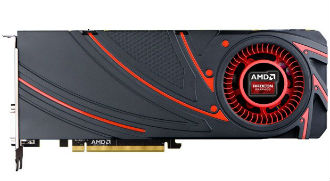 AMD has lifted the NDA veil off its new flagship Radeon card and the first reviews and products announcements are popping up on the interweb. The press loves the R9 290X. AMD went to great lengths to keep the launch price a secret until the last possible moment, which appears to have been a very good move.
AMD has lifted the NDA veil off its new flagship Radeon card and the first reviews and products announcements are popping up on the interweb. The press loves the R9 290X. AMD went to great lengths to keep the launch price a secret until the last possible moment, which appears to have been a very good move.
Most observers were expecting the new card to launch with a $599 or even $699 price tag, but it ended up at $549. This sounds like a very good deal as it wipes the floor with Nvidia’s $649 GTX 780 and it can even take on Nvidia’s $999 Titan card in some tests. Clearly Nvidia will have to do something to counter AMD’s launch and it already has a new version of the GTX 780 in the works, but pricing will be a problem and the R9 290X will erode Nvidia’s margins on GK110 products.
As far as specs go, the R9 290X is the first card based on AMD’s new Hawaii GPU. It features GCN 2.0 architecture, 512-bit memory bus, 2,816 shaders and it’s the biggest GPU AMD has ever built. Reviews indicate that performance is not an issue, although the card tends to get hot and loud in AMD’s high performance “Uber” mode. The cooler is not that great, which leaves a lot of room for AIB partners to play around with custom designs.
Another question is the Pro version, or the R9 290. The NDA will reportedly be lifted in a week and there is still no word on the price. The XT-based R9 290X is shaping up to be quite a performer, but the Pro version will offer plenty of performance at a much more attractive price point. However, it is still unclear how AMD plans to price it. At $449 it would be a nice deal, but if AMD really chooses to stick it to Nvidia and sacrifice margin, it might end up at $399, which would be very disruptive.
Nvidia has already reduced the prices of its sub-$199 cards to counter AMD’s rebranded R7 and R9 series products. Now it remains to be seen how low it can go and it won’t be easy – Nvidia’s GK110 GPU has about a billion transistors more than AMD’s Hawaii, which makes it quite a bit more expensive to produce, yet it ends up slower in most versions.
See Also
AMD declares war on Nvidia
 In a bid to generate more revenues, graphics firm Nvidia is to start licensing its GPU designs to other companies.
In a bid to generate more revenues, graphics firm Nvidia is to start licensing its GPU designs to other companies. In a bid to generate more revenues, graphics firm Nvidia is to start licensing its GPU designs to other companies.
In a bid to generate more revenues, graphics firm Nvidia is to start licensing its GPU designs to other companies.





